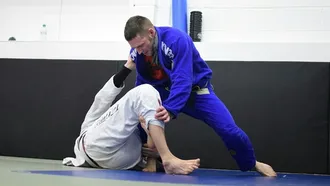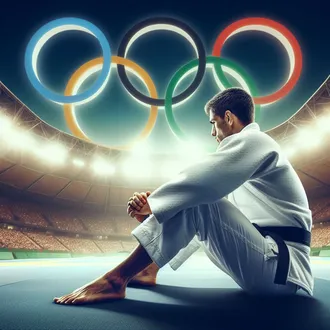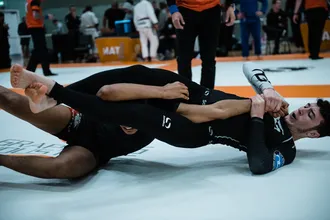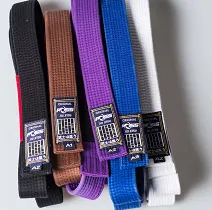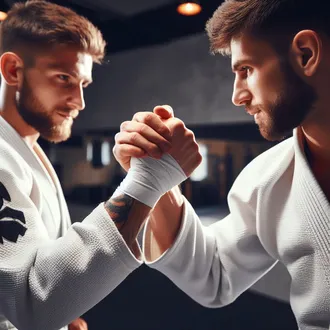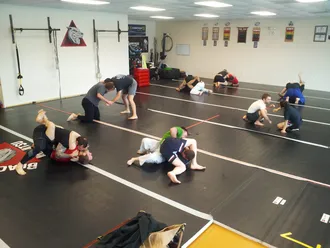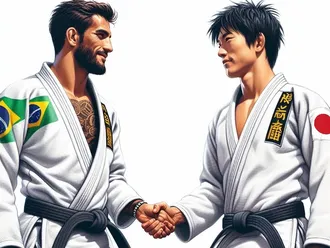
Brazilian Jiu-Jitsu (BJJ) has become a globally recognized martial art, known for its effectiveness in ground fighting, self-defense, and competition. However, its roots trace back to a lesser-known yet historically rich martial art—Japanese Jujutsu (JJJ).
Japanese Jujutsu, developed centuries ago by samurai warriors, focuses on a combination of strikes, joint locks, throws, and submission techniques designed for survival in close combat. In contrast, BJJ evolved as a specialized system emphasizing ground grappling, leverage, and positional control.
With the global spread of Brazilian Jiu-Jitsu, its influence has even reached Japan, the birthplace of traditional Jujutsu. But how does BJJ compare to its predecessor? How popular is BJJ in Japan? And is BJJ better than Japanese Jujutsu?
This article explores the historical connections, technical differences, training philosophies, and the growing presence of BJJ in Japan to provide a well-rounded comparison of these two influential martial arts.
History of Japanese Jujutsu and Brazilian Jiu-Jitsu
Imagine a samurai warrior on the battlefield, disarmed and facing a formidable opponent. This very scenario gave birth to Japanese Jujutsu (JJJ), a martial art developed for survival in close combat.
Rooted in Japan’s feudal era, JJJ was designed to help warriors defend themselves using grappling, joint locks, throws, and strikes. It became a comprehensive system that relied on efficiency rather than brute strength.
During the Sengoku period (1467-1603), Japan was a land of constant warfare. Samurai warriors trained in JJJ to subdue opponents without weapons, utilizing leverage and precise technique.
Over time, JJJ influenced the development of other martial arts, including Judo. When Judo spread internationally, it eventually reached Brazil, where the Gracie family adapted its techniques, giving birth to what we now know as Brazilian Jiu-Jitsu (BJJ).
Unlike its predecessor, BJJ focused primarily on ground-based combat, refining submission techniques and positional control. This shift made BJJ one of the most effective martial arts for self-defense and competitive grappling.
The Evolution of Japanese Jujutsu Schools
As Japanese Jujutsu (JJJ) evolved over centuries, numerous ryu (schools) emerged, each refining and specializing in different techniques. These schools influenced the development of modern martial arts, including Judo and Brazilian Jiu-Jitsu.
Some of the most influential Japanese Jujutsu schools include:
- Kito Ryu: Focused on throwing techniques and breaking an opponent’s balance, later influencing Judo.
- Daito Ryu Aikijujutsu: Specialized in joint locks and pressure-point manipulation, serving as the foundation for Aikido.
- Tenjin Shinyo Ryu: Integrated striking, joint locks, and grappling into a complete combat system.
While these schools emphasized self-defense, battlefield tactics, and control over an opponent, the evolution of JJJ into Judo and later Brazilian Jiu-Jitsu introduced a more sport-oriented approach.
Brazilian Jiu-Jitsu, influenced primarily by Judo, moved away from traditional Japanese training forms (kata) and focused on live sparring (rolling), making it a highly effective grappling system in modern combat sports.
Philosophy and Principles of BJJ vs Japanese Jujutsu
While both BJJ and Japanese Jujutsu share a foundation in grappling, their philosophies reflect distinct cultural and historical influences.
Brazilian Jiu-Jitsu: The Art of Problem-Solving
Brazilian Jiu-Jitsu emphasizes adaptability, leverage, and technique to overcome physical disadvantages. Its philosophy revolves around problem-solving and strategic thinking, making it one of the most effective martial arts for real-world self-defense and competition.
Key principles of BJJ include:
- Leverage over strength: A smaller, weaker person can defeat a larger opponent using technique.
- Continuous learning: Every sparring session (rolling) is an opportunity to improve.
- Live training: BJJ is practiced with full resistance, making it highly effective for real-world scenarios.
Japanese Jujutsu: A Holistic Approach
Traditional Japanese Jujutsu is deeply rooted in samurai ethics, discipline, and efficiency. It incorporates a mix of grappling, strikes, and sometimes even weapon techniques.
Principles of JJJ include:
- Maximum efficiency, minimal effort: Use an opponent’s energy against them.
- Respect and tradition: Etiquette and discipline play a significant role in training.
- Comprehensive training: Includes striking, joint locks, throws, and sometimes weapons.
While BJJ focuses on ground fighting and positional control, Japanese Jujutsu offers a broader spectrum of techniques, including stand-up grappling and striking.
Techniques in Japanese Jujutsu vs Brazilian Jiu-Jitsu
Both Japanese Jujutsu (JJJ) and Brazilian Jiu-Jitsu (BJJ) offer a diverse set of techniques, but their applications differ significantly.
Throws and Takedowns
JJJ utilizes powerful throws inspired by Judo, such as hip throws (O-Goshi) and sacrifice throws (Tomoe-Nage). These techniques focus on off-balancing the opponent and redirecting their force.
BJJ, on the other hand, borrows Judo throws but prioritizes wrestling-style takedowns, such as single-leg and double-leg takedowns, to bring the fight to the ground where it excels.
Joint Locks
Both arts use joint locks, but with different applications:
- JJJ joint locks: Often applied from standing positions, aiming to disable or control an attacker.
- BJJ joint locks: Primarily executed on the ground, leading to submission victories in competition.
Ground Fighting
Ground combat is where BJJ excels. Unlike JJJ, which often aims to maintain a standing position, BJJ practitioners train extensively in guard positions, sweeps, escapes, and submissions.
Common BJJ ground techniques include:
- Triangle Choke – A submission using the legs to choke the opponent.
- Armbar – A hyperextension lock targeting the elbow joint.
- Rear Naked Choke – A powerful strangulation from behind.
Striking Techniques
JJJ includes striking (Atemi-waza), while BJJ does not focus on striking in its modern form.
However, self-defense-oriented BJJ (as taught by the Gracie family) incorporates striking awareness to handle real-world altercations.
Training Methods and Competition Formats
Both Japanese Jujutsu (JJJ) and Brazilian Jiu-Jitsu (BJJ) utilize structured training methods, but their approaches and competitive formats differ significantly.
Japanese Jujutsu Training: Tradition and Forms
JJJ training incorporates a blend of structured kata (pre-arranged forms), partner drills, and controlled sparring (randori). Some traditional schools still emphasize:
- Self-defence drills: Practicing real-world scenarios involving strikes, joint locks, and throws.
- Kata (forms): Pre-arranged sequences to develop technique and discipline.
- Weapons training: Some JJJ styles incorporate training with swords, staffs, or knives.
Since traditional JJJ was not designed for sport, competition formats are limited, with some schools focusing on demonstration-based tournaments rather than live sparring.
Brazilian Jiu-Jitsu Training: Live Sparring and Adaptability
BJJ training revolves around positional drills, live sparring (rolling), and competitive grappling. Unlike JJJ, BJJ practitioners train at full intensity against resisting opponents, allowing them to develop real-world application skills.
Key aspects of BJJ training include:
- Positional control drills: Practicing sweeps, escapes, and submissions.
- Rolling (live sparring): A key part of training that simulates real grappling scenarios.
- Competition-focused training: Many practitioners train specifically for tournaments.
Competition Formats: BJJ vs JJJ
While Japanese Jujutsu does not have a standardized competition scene, Brazilian Jiu-Jitsu has an extensive competitive landscape with various rule sets.
Brazilian Jiu-Jitsu Competitions
BJJ tournaments follow different rule systems, including:
- IBJJF (International Brazilian Jiu-Jitsu Federation): The most common format, featuring points-based matches with strict rules.
- ADCC (Abu Dhabi Combat Club): A submission grappling competition that allows a wider range of techniques.
- No-Gi Competitions: Matches without the traditional gi, often allowing for faster-paced grappling.
These tournaments test a practitioner's ability to control and submit opponents under pressure, making BJJ one of the most competitive martial arts in the world.
Japanese Jujutsu Demonstrations and Limited Competitions
Since JJJ was designed for self-defense rather than sport, competitions are rare. However, some modern adaptations of JJJ include:
- Randori (light sparring): Some schools incorporate controlled live sparring for practical application.
- Kata-based tournaments: Events where practitioners demonstrate techniques in pre-arranged sequences.
- Hybrid formats: Some modern JJJ schools have introduced competition-style events that incorporate grappling.
While JJJ remains deeply rooted in tradition, BJJ’s competitive evolution has made it one of the most widely practiced grappling martial arts in the world.
Belt Systems: Ranking in Japanese Jujutsu vs Brazilian Jiu-Jitsu
The ranking structures in Brazilian Jiu-Jitsu and Japanese Jujutsu differ significantly. While both use colored belts to signify progress, their criteria for advancement and the number of belt ranks vary.
BJJ Belt System: A Competitive Progression
The Brazilian Jiu-Jitsu belt system is structured with fewer belts, focusing heavily on competition performance and live sparring skills.
In most BJJ academies, the belt progression is as follows:
- White Belt: Beginner level, learning fundamental techniques.
- Blue Belt: Demonstrates knowledge of escapes, sweeps, and submissions.
- Purple Belt: Intermediate level, focusing on refining strategy and technique.
- Brown Belt: Advanced level, preparing for black belt.
- Black Belt: Expert level, typically taking a decade or more to achieve.
Unlike many traditional martial arts, BJJ ranks are often awarded based on skill and performance in sparring rather than formal testing. Additionally, BJJ incorporates a stripe system within each belt to track progress.
For those who continue training, BJJ also offers advanced ranks beyond black belt, such as the coral belt and red belt, which are typically reserved for lifelong practitioners.
Japanese Jujutsu Belt System: Traditional Ranking
Traditional Japanese Jujutsu follows a more extensive ranking system with multiple intermediate belts.
A typical JJJ belt progression includes:
- White Belt: Entry-level rank for beginners.
- Yellow Belt: Basic techniques introduced.
- Orange Belt: More advanced strikes, joint locks, and throws.
- Green Belt: Increasing focus on fluid movement and combination techniques.
- Blue Belt: Greater proficiency in self-defense applications.
- Purple Belt: Demonstrates deeper knowledge of traditional forms (kata).
- Brown Belt: Advanced understanding of principles and applications.
- Black Belt: Considered an expert level, but still a student of the art.
JJJ’s belt system often varies by school, and some styles also include dan (degree) rankings beyond black belt.
Key Differences in BJJ vs JJJ Belt Systems
- Number of belts: BJJ has fewer ranks, while JJJ includes multiple intermediate belts.
- Testing methods: BJJ focuses on live sparring for promotion, whereas JJJ often includes formal testing and kata demonstrations.
- Time to black belt: BJJ black belts take an average of 10+ years to achieve, while JJJ black belts may be awarded in fewer years depending on the school.
While both systems reward dedication and skill, BJJ emphasizes competitive ability, whereas JJJ maintains a more traditional ranking approach.
BJJ in Japan: The Return of Jiu-Jitsu
Despite its origins in Japanese Jujutsu, Brazilian Jiu-Jitsu (BJJ) made its way back to Japan in the late 20th century, largely due to the influence of mixed martial arts (MMA) and global grappling competitions.
Japan has long been a hub for combat sports, hosting major promotions like Pride FC and Rizin, which helped expose BJJ’s effectiveness to a broader audience. As a result, BJJ gained traction among martial artists, judokas, and MMA fighters looking to refine their ground game.
Today, Japan is home to a growing BJJ community, with academies such as Carpe Diem BJJ, Axis BJJ, and Tri-Force Jiu-Jitsu producing high-level competitors. Organizations like the Japan Brazilian Jiu-Jitsu Federation (JBJJF) have also played a key role in promoting the sport through structured tournaments and ranking systems.
With its rich martial arts heritage, Japan has embraced BJJ not as a replacement for traditional Jujutsu or Judo, but as an evolving art that complements existing styles.
Is BJJ Popular in Japan?
While Japan remains deeply connected to traditional martial arts like Judo, Karate, and Kendo, Brazilian Jiu-Jitsu has steadily gained popularity over the past two decades.
Major cities such as Tokyo, Osaka, and Nagoya have thriving BJJ communities, with numerous academies catering to both hobbyists and professional competitors.
Several factors have contributed to BJJ’s growing popularity in Japan:
- MMA Influence: The rise of MMA in Japan has encouraged fighters to integrate BJJ into their training.
- Self-Defense Appeal: Many Japanese practitioners appreciate BJJ’s focus on leverage and technique over brute strength.
- International Success: Japanese athletes have gained recognition in major competitions, boosting local interest.
Although Judo continues to dominate Japan’s grappling culture, BJJ is carving out a dedicated following, especially among younger martial artists and MMA enthusiasts.
FAQs: Brazilian Jiu-Jitsu vs. Japanese Jujutsu
Is BJJ practiced in Japan?
Yes! Brazilian Jiu-Jitsu (BJJ) has a growing presence in Japan. While Judo remains the dominant grappling martial art, BJJ has gained popularity, especially in major cities like Tokyo, Osaka, and Nagoya. Many Judokas and MMA fighters train in BJJ to improve their ground game. Top academies such as Carpe Diem BJJ, Axis BJJ, and Tri-Force Jiu-Jitsu are helping expand the sport.
Is BJJ better than Japanese Jiu-Jitsu?
It depends on what you’re looking for. BJJ focuses on ground fighting, submissions, and positional control, making it highly effective in sport grappling and self-defense situations. Japanese Jujutsu (JJJ), on the other hand, includes a mix of strikes, throws, joint locks, and even some weapon defenses, making it a more traditional martial art. If you want a modern, sport-based grappling system, BJJ is a better choice. If you prefer a broader self-defense approach with striking, JJJ might be a better fit.
Is BJJ popular in Japan?
Yes! BJJ is steadily growing in popularity in Japan, thanks to the rise of MMA promotions like Pride FC and Rizin, which showcased its effectiveness. The Japan Brazilian Jiu-Jitsu Federation (JBJJF) organizes tournaments across the country, and more martial artists are embracing BJJ as a complementary skill alongside Judo and traditional Jujutsu.
Is BJJ originally Japanese?
BJJ has Japanese roots but evolved in Brazil. It originated from Judo, which itself came from Japanese Jujutsu. In the early 1900s, Mitsuyo Maeda, a Judo master, brought his grappling expertise to Brazil, where the Gracie family refined and developed it into Brazilian Jiu-Jitsu. So while BJJ’s foundation is Japanese, its evolution and modern application are distinctly Brazilian.
How did Japanese Jujutsu evolve into BJJ?
Through Judo! Japanese Jujutsu influenced the creation of Judo in the late 19th century, thanks to Jigoro Kano. When Judo spread internationally, it reached Brazil, where the Gracie family modified its techniques to emphasize ground fighting and submissions, leading to the development of Brazilian Jiu-Jitsu.
Does Japanese Jujutsu have ground fighting?
Yes, but not as extensively as BJJ. Japanese Jujutsu includes some ground techniques, but its primary focus is on standing grappling, joint locks, and throws. BJJ, on the other hand, specializes in positional control, sweeps, and submissions, making it far more effective in ground-based combat.
How do the belt systems in BJJ and Japanese Jujutsu differ?
BJJ’s belt system is structured around live sparring ability and has fewer ranks:
- White – Beginner
- Blue – Fundamental techniques down
- Purple – Intermediate level
- Brown – Advanced
- Black – Expert
In contrast, Japanese Jujutsu has more intermediate belts, including yellow, orange, and green, and often incorporates formal testing and kata demonstrations for promotions.
Do BJJ competitions exist in Japan?
Absolutely! Japan hosts numerous BJJ tournaments, including those organized by the Japan Brazilian Jiu-Jitsu Federation (JBJJF). Many Japanese competitors also participate in international BJJ events, such as IBJJF tournaments and ADCC submission grappling competitions.
Does BJJ have striking?
Not in its modern sport format, but self-defense-oriented BJJ, as taught by the Gracie family, includes striking awareness. Traditional Japanese Jujutsu, however, incorporates striking techniques (Atemi-waza) alongside grappling.
Which is better for self-defense: BJJ or Japanese Jujutsu?
BJJ is excellent for one-on-one self-defense. Its ground-fighting techniques allow a smaller person to neutralize a larger attacker. However, Japanese Jujutsu covers a wider range of attacks, including strikes and weapon defenses, making it more adaptable in certain situations.
Parting Thoughts: Embracing the Journey of BJJ and Japanese Jujutsu
Brazilian Jiu-Jitsu and Japanese Jujutsu are more than just martial arts—they are lifelong paths of self-improvement, discipline, and personal growth. Both arts offer unique strengths, shaping practitioners physically and mentally while instilling valuable lessons that extend beyond the dojo.
Brazilian Jiu-Jitsu thrives on adaptability, problem-solving, and live training, making it a powerful tool for self-defense and competition.
Japanese Jujutsu preserves the traditions of the samurai, emphasizing efficiency, balance, and a holistic approach to self-protection.
Despite their differences, both arts share a common goal: empowering individuals through skill, perseverance, and community. Whether you train in BJJ or JJJ, you will develop:
- Physical fitness – Improving strength, endurance, and flexibility.
- Mental discipline – Sharpening problem-solving skills, patience, and focus.
- Confidence and self-defense skills – Learning how to remain calm under pressure.
- A sense of community – Becoming part of a group that supports your journey.
At their core, both arts teach us to be adaptable, resilient, and humble. Whether you are drawn to the strategic ground game of BJJ or the traditional elegance of JJJ, the journey is what truly matters. Embrace the training, respect the roots, and enjoy the process—because in martial arts, growth never stops.
